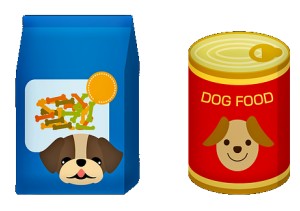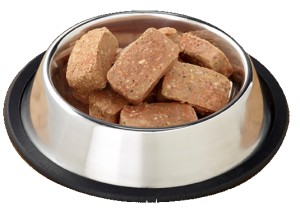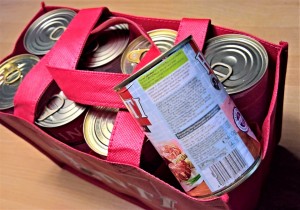Truth and Lies on Dog Food Packages – Secrets the Dog Food Companies Don't Want You to Know
By Michele Welton, Dog Trainer, Breed Selection Consultant, Author of 15 Dog Books
3 Best Ways To Feed Your Dog Healthy Food
What Every Puppy Owner Should Know About Feeding
A Quick Way to Make Homemade Dog Food
Pros and Cons of Raw vs Cooked
What Makes a Dog Food Good – or Awful
→ Truth and Lies on Dog Food Packages
5 Best Kibble and Canned Dog Foods
5 Reasons Not To Feed Your Dog Grains
Two Shocking Reasons Vets Recommend Kibble and Canned Dog Food
How To Tell If Your Dog Is Overweight – And What To Do About It
Let's start with the official ingredients

Study the package of dog food carefully. The manufacturer is doing his best to make you buy, which (unfortunately) includes misleading you. You need to know what to look for, and look out for!
What kind of meat, and how much?
1) The meat should be NAMED. Beef. Chicken. Turkey. Duck. Bison. Venison. Salmon.
If the package just says meat meal or animal digest, the manufacturer is deliberately creating wiggle room so they can search the open market for the cheapest ingredient. Then you'll never know what your dog is actually eating.
2) A named meat/fish should be the first ingredient AND the second ingredient AND preferably the third or fourth ingredient as well. The more, the better!
For example, this:
- Chicken, chicken liver, chicken heart....
- Beef, beef liver, beef kidney, beef spleen....
- Duck, duck necks, organic kale, whole sardines....
- Turkey meal, chicken meal, eggs, whitefish meal....
NOT this:
- Chicken, tapioca, chicken fat, lentils, squash... not enough meat
- Turkey, oatmeal, brown rice, peas, turkey meal.... not enough meat
- Chicken, whole grain wheat, cracked barley, whole grain sorghum.... garbage
- Corn gluten meal, meat and bone meal, turkey meal, soybean meal.... complete garbage
Are there any grains or cereals in the food?
 Wheat, corn, soybean, barley, rice, oats, sorghum.... why are grains and cereals found in dog food?
Wheat, corn, soybean, barley, rice, oats, sorghum.... why are grains and cereals found in dog food?
Because grains and cereals contain a little protein, and dogs need protein. Meat is the perfect protein for dogs – the only protein, in fact, that dogs are born to digest.
But meat is expensive! Thus all the manufacturers who are focused on their bottom line use as little meat as they can get away with. That means they need a meat substitute that provides some protein.
Enter grains and cereals.
For decades, pet food companies have stuffed their concoctions with grains and cereals and slapped Dog Food on the label. Billions of dollars in marketing money has sold that idea to the public.
But dogs were never designed to digest grains and cereals. Much of it goes right through them, resulting in lots of waste to clean up. Dogs eating grains and cereals often develop itchy allergies and digestive ailments. And grains and cereals contain a lot of unnecessary carbs, which is a major reason we see so many overweight (and unhealthy) dogs.
Thankfully, more and more dog owners have discovered that dogs should not be eating grain. Grain-free diets are now in big demand. Which means the pet food companies need a different source of cheap protein.
They discovered.... drumroll.... legumes.
Are there any legumes in the food you're looking at?
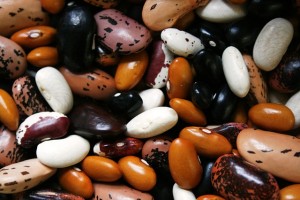 As cheap substitutes for meat protein, legumes now populate many dog foods. Green peas, pea starch, pea protein, pea fiber, pea flour, chickpeas, soybeans, kidney beans, lentils....
As cheap substitutes for meat protein, legumes now populate many dog foods. Green peas, pea starch, pea protein, pea fiber, pea flour, chickpeas, soybeans, kidney beans, lentils....
Legumes are high in protein, yes, but (as with grains and cereals) legumes are NOT the kind of protein that's well-digested by dogs. Legumes can cause intestinal discomfort and flatulence. And they're high in unneeded carbs.
Even more ominously, there is suspicion/concern that feeding too many legumes (as meat substitutes) might be triggering a specific form of heart disease in some dogs.
Are there any starchy vegetables in the food?
Red or white potatoes? Sweet potatoes or yams? Butternut squash? Corn? These starchy, high-carb foods are alien to a dog's digestive system.
They get converted into glucose very quickly, which causes your dog's blood sugar to spike, predisposing him to a condition called insulin resistance or diabetes.
If I HAD to choose one starchy vegetable in my dog's food, I would choose sweet potato or butternut squash, rather than regular potatoes or corn.
Are there any extra oils in the food?
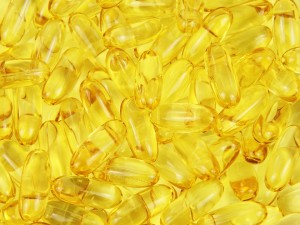 Many commercial foods include oils. I always prefer that the oil be named. I especially like to see wild-caught salmon oil because its fatty acids are high-quality with the lowest levels of toxic mercury and other contaminants.
Many commercial foods include oils. I always prefer that the oil be named. I especially like to see wild-caught salmon oil because its fatty acids are high-quality with the lowest levels of toxic mercury and other contaminants.
I'm less enthused about generic fish oil, where the manufacturer has wiggle room to include the cheapest fish available, which often contain higher levels of contaminants and lower-quality fatty acids.
Some foods use flaxseed oil (or ground flaxseed) or another plant-based oil such as sunflower. These are okay, but....
Dogs can't break down plant-based oils as well as fish-based oils. I wouldn't turn down a dog food with flaxseed, but I prefer salmon oil.
Are there any ingredients you don't recognize as food?
Starting at about the middle of the ingredients list, you'll often see a long list of synthetic vitamins and minerals, like this:
potassium chloride, dl-methionine, l-lysine, taurine, l-carnitine, beta-carotene, vitamin A, vitamin D3, vitamin E, zinc sulfate, ferrous sulfate, niacin, folic acid, biotin, etc....
Those aren't awful ingredients, but it's much better for a dog to obtain his vitamins and minerals from the actual FOOD itself.
- When a dog food is truly canine-appropriate, with plenty of high-quality meats, plenty of high-quality fats, and very few carbs, virtually all of the vitamins and minerals will already be there and the company will add only the few that are missing.
- When a dog food isn't canine-appropriate (contains meat substitutes such as grains, cereals, legumes, starchy vegetables), the company has to throw in all the synthetic vitamins and minerals, which are never as well-absorbed as the real thing.
 Junk fillers that shouldn't be in any dog food include rice flour, rice bran, brewers rice, corn gluten meal, wheat middlings, alfalfa meal, animal digest, and others. None of this stuff belongs in your dog's food bowl.
Junk fillers that shouldn't be in any dog food include rice flour, rice bran, brewers rice, corn gluten meal, wheat middlings, alfalfa meal, animal digest, and others. None of this stuff belongs in your dog's food bowl.
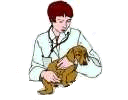 Australian veterinarian Dr. Ian Billinghurst says:
Australian veterinarian Dr. Ian Billinghurst says:
"If you look at the ingredient list on a can or a bag of pet food – with understanding – you will realise that what is being listed is a heap of rubbish. Definitely not the wholesome nutritious food you would want to feed to a valued member of your family."
In summary, the ingredients I like to see: The first two or three (or more) ingredients should be a specific meat or fish. I want NO grains or corn anywhere on the list. No (or maybe ONE) legume such as lentils. No (or maybe ONE) starchy vegetable: sweet potato or butternut squash. And NO unrecognizable ingredients or junk fillers as listed above.
Next, look at the Guaranteed Analysis (GA).
After examining the list of Ingredients, turn to the Guaranteed Analysis (GA), which is a label on the package or can that gives percentages of protein, fat, etc.
| Brand X | |
|---|---|
| Protein (min) | 8% |
| Fat (min) | 7% |
| Moisture (max) | 78% |
Unfortunately, as you'll soon see, GA labels are pretty much useless.
The problem is the MOISTURE.
78% of this food is simply water used during processing. Moisture contains no nutrients, so you need to subtract that 78% from 100% and you get 22%. That means only 22% of the can contains nutrients. You're paying an awful lot for water.
Since only 22% of the can contains nutrients, and since the can says the protein is 8%, what's 8% of 22%? Break out your trusty calculator! Press 8 divided by 22 = 0.36 (that's 36%). 36% of the nutrients are protein. A far cry from 8%, isn't it?
Now the fat. The can says 7%. Press 7 divided by 22 = 0.32 (that's 32%).
So when you factor out the moisture, the GA now looks like this:
| Brand X | |
|---|---|
| Protein (min) | 36% |
| Fat (min) | 32% |
| ? | ? |
These figures are called Dry Matter, for obvious reasons. We factored out the moisture, right?
But what should go into that slot with the ?
Carbohydrates. There are 3 nutrients in food: protein, fat, carbs.
Once we know the protein and fat, it's easy to find the carbs. The three of them must add up to 100. So 100 minus 36 protein minus 32 fat equals 32 carbs. This food has 32% carbs.
| Brand X | |
|---|---|
| Protein (min) | 36% |
| Fat (min) | 32% |
| Carbs | 32% |
Yay! We've figured it all out!
Except....
Remember when I said that GA labels were pretty useless?
It turns out the manufacturer hasn't really given us the percentages of protein, fat, and moisture that's in the food.
See where it says Protein (min)? Fat (min)?
You can guess what min stands for: minimum.
The Guaranteed Analysis label doesn't tell you how much protein and fat is really in the food. It just gives minimums. It's guaranteeing there's at least that much. It could be more.
Which means those numbers we so cleverly figured out with our calculator (36% protein, 32% fat, 32% carbs) were based on numbers on the label that might or might not be the actual percentages in the food.
We just wasted 3 minutes of our lives that we'll never get back.
But.... but.... then how can you know how much protein, fat, and carbs there really ARE in the food?

Indeed! You need to contact the company and ask:
"I'm not looking for the minimum percentages. I'd like to know exactly how much dry matter protein, fat, and carbs are in your Brand X."
What answers should you be hoping for?
I prefer at least 50% protein. Then, whatever that number is, I divide it in half and that's the maximum % of fat I prefer.
For example, if the company says 50% protein, half of 50% is 25%, so I want the fat to be no more than 25%.
But I really want it to be LESS, more like 21 or 22%. I want the fat % to be so much lower than the protein % because fat contains over twice as many calories as protein does.
That's another problem with the Guaranteed Analysis. The percentages on that label are by weight and that's a less useful measurement than percentages by calories.
So if you're going to call or send the company an email anyway, why not simply ask for more useful numbers? Ask them: "In Brand X, what percentage of my dog's calories come from protein, from fat, and from carbs?"
With this better question, what answers should you be hoping for?
Well, a dog's ancestral/natural diet (rabbits, mice, deer, fish, grasshoppers...) looks like this:
| Calories From Protein | 45-55% |
| Calories From Fat | 35-45% |
| Calories From Carbs | 0-20% |
That chart contains the calorie percentages that most dogs should be eating. Sadly, the vast majority of commercial brands are too low in protein, too high in fat, or too high in carbs. Manufacturers are NOT making dog food that's best for your dog. They're making what they think the (uninformed) public will buy, at the highest profit to the manufacturer.
Finally, read over the rest of the package.
Sadly, "the rest of the package" is often the ONLY thing that dog owners look at. Their eyes are drawn to those lovely pics of sirloin steaks, cows grazing contentedly in the pasture, hens pecking happily in the barnyard. And above all, happy healthy-looking dogs.
All of which is marketing schlock designed to mislead you.
Instead, look for some key pieces of information:
1) Does the package (or the company's website) actually say that their ingredients (especially their MEATS) are human-grade or human-edible or approved for human consumption?
If it doesn't say that.... they aren't.
Stay alert! Some companies will claim their ingredients "come from USDA "inspected" facilities.
That means nothing. The vast majority of ingredients in pet food come from USDA "inspected" facilities.
If those ingredients had actually passed the inspection, the company would have said so. Instead, the vast majority of ingredients from USDA "inspected" facilities FAILED the inspection for human consumption... and so were thrown into the pet food bin.
This rejected stuff is called Feed Grade. Some Feed Grade ingredients are okay for a dog to eat, while others are truly dreadful, including 4D meat from livestock that were Diseased, Disabled, Dying, or already Dead when it arrived at the slaughterhouse.
Takeaway: If you really don't want your dog eating that crap, you should find out from the company whether their ingredients are USDA-approved for human consumption. Not just inspected. Approved. The vast majority of dog food is not.
While dogs can definitely eat things humans can't, even a dog may not be able to stomach what some pet food companies produce in their mass production facilities.
When your dog eats Feed Grade pet food, there was no objective party, no state or federal department, regulating or watching over the processing or safety of his food.
In case you're wondering, all dry kibble and canned dog foods are Feed Grade. Just something to think about.
2) Does the package (or the company's website) say their meat and eggs are sourced from pastured/grass-fed livestock and free-range poultry?
If it doesn't say that.... they aren't.
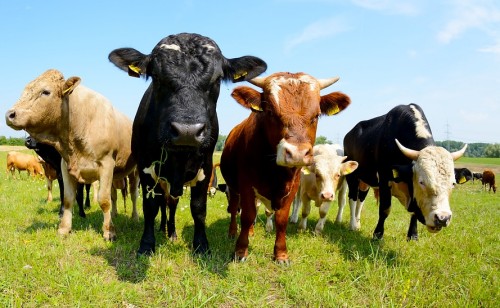
Grass-fed, free-range meat and eggs are healthier to eat, and it's certainly a more humane way to raise livestock.
3) Does the package (or the company's website) say that all ingredients are sourced from the US, Canada, or Europe?
If it doesn't say that.... they aren't.
Not specifying their sources means the manufacturer can scout around for the cheapest prices. That increases his profits, but possibly at the expense of your dog's safety.
You don't want your dog's food to include ingredients from countries with a poor history of quality control. Especially China.
4) Does the package (or the company's website) say their vegetables and fruits are certified organic?
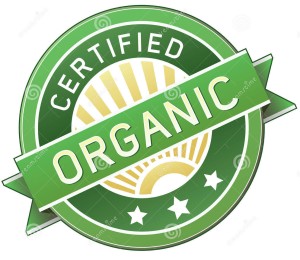
If it doesn't say that.... they aren't.
Since veggies/fruits should only be a very small part of a dog food (less than 20%), I wouldn't turn down a food if its veggies/fruits weren't certified organic.
But it's always nice to know that your dog isn't eating stuff sprayed with chemicals.
What about all the other information on the package or company website?
"Science-based nutrition.... biology-based dog food.... balanced nutrition.... highest quality protein.... helps clean your dog's teeth.... made with love...."
Of course they're going to say stuff like that. It's marketing. And meaningless.
Here's all I want to know:
- Is the food front-loaded with meat, meat, meat? (or fish?)
- Are there NO (or maybe just ONE) grains, legumes, or starchy vegetables?
- Are the ingredients approved/passed inspection for human consumption, or not?
- Do the ingredients come from grass-fed, free-range livestock?
- Do all of the ingredients come from the US, Canada, Australia, New Zealand, or the European Union?
- How many calories from protein? 45-55%?
- How many calories from fat? 35-45%?
- How many calories from carbs? 0-20%?
How many commercial pet foods tick all those boxes? None. Unless you're making your dog's food yourself, you can never control the ingredients, especially their quality and source. When you buy a commercial dog food, you're always going to compromise on something. It's up to you what you choose to compromise on.
MORE ABOUT FEEDING
HONEST ADVICE ABOUT TRAINING
My best-selling books – now available FREE on my website
 Respect Training For Puppies: 30 seconds to a calm, polite, well-behaved puppy is for puppies 2 to 18 months old. Your puppy will learn the 21 skills that all family dogs need to know. Click here to read for free.
Respect Training For Puppies: 30 seconds to a calm, polite, well-behaved puppy is for puppies 2 to 18 months old. Your puppy will learn the 21 skills that all family dogs need to know. Click here to read for free. Teach Your Dog 100 English Words is a unique Vocabulary and Respect Training Program that will teach your adult dog to listen to you and do what you say. Click here to read for free.
Teach Your Dog 100 English Words is a unique Vocabulary and Respect Training Program that will teach your adult dog to listen to you and do what you say. Click here to read for free. 11 Things You Must Do Right To Keep Your Dog Healthy and Happy helps your dog live a longer, healthier life. Get my honest advice about all 11 Things before you bring home your new puppy, because some mistakes with early health care cannot be undone. Click here to read for free.
11 Things You Must Do Right To Keep Your Dog Healthy and Happy helps your dog live a longer, healthier life. Get my honest advice about all 11 Things before you bring home your new puppy, because some mistakes with early health care cannot be undone. Click here to read for free.

